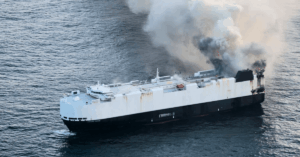
Sudden Storm Caused Tugboat To Capsize Off Galveston, NTSB Reports
June 4, 2025
Japan Opens Vast Exclusive Economic Zone For Offshore Wind Projects
June 5, 2025

A cargo ship carrying more than 3,000 vehicles, including hundreds of electric and hybrid cars, was abandoned in the Pacific Ocean this week after a fire broke out on board and the crew failed to bring it under control.
All 22 crew members were safely rescued with no reported injuries.
The ship, Morning Midas, was sailing from Yantai, China, to Lázaro Cárdenas, Mexico, when the fire was detected on Tuesday afternoon, June 3. The vessel was about 300 miles south of Adak Island in Alaska’s Aleutian chain, approximately 1,200 miles from Anchorage.
According to Zodiac Maritime, the London-based company managing the ship, smoke was first seen coming from the stern area where electric vehicles were stored. The 600-foot ship, built in 2006 and sailing under a Liberian flag, was carrying 3,048 vehicles, of which 70 were fully electric and 681 were partial hybrid electric vehicles. Earlier estimates had suggested about 800 EVs were on board.
The crew immediately activated the ship’s CO₂-based fire suppression system. However, officials said the fire reignited after the system’s CO₂ was fully used. The blaze continued to burn stubbornly, and the crew was forced to abandon the vessel using a lifeboat.
The U.S. Coast Guard said it received a distress alert at around 3:15 p.m. on Tuesday. Coast Guard officials sent an Urgent Marine Information Broadcast, requesting help from nearby vessels.

Three commercial ships responded, and the crew was rescued by the Cosco Hellas, a Malta-registered containership. All rescued crew members are in good condition.
The Coast Guard also deployed the Cutter Munro, launched a C-130J Super Hercules aircraft from Kodiak, and placed an MH-60T Jayhawk helicopter crew in Adak in case air support was needed.
As of Wednesday morning, June 4, the Morning Midas was still on fire, with smoke rising from the vessel. The ship is believed to be carrying around 1,530 metric tons of very low-sulfur fuel oil and 350 metric tons of gas fuel.
A fire safety director from the International Association of Fire Fighters said the way the CO₂ system failed to stop the blaze suggests the fire likely started from an electric vehicle battery.
Fires involving lithium-ion batteries are difficult to extinguish, often resisting foam and small amounts of water. According to a fire investigator based in Florida, it can take as much as 10,000 gallons of water to fully extinguish a single EV battery fire. Using such large volumes of water on a ship raises the risk of sinking it before the fire is put out.

The risk of fire spreading from one EV battery to another in a chain reaction is also high, experts said. Even using seawater poses problems, as its salt content can corrode equipment and lead to further short circuits.
The Coast Guard said it is now coordinating with Zodiac Maritime to determine how to handle the damaged vessel. A tugboat has been deployed to the scene for salvage and firefighting efforts.
The commander of the Coast Guard’s Seventeenth District, Rear Admiral Megan Dean, thanked the nearby merchant ships that responded and praised the rescue effort.
Industry records show that the Morning Midas had fire safety and rescue boat issues during a port inspection in Bremerhaven, Germany, in October 2024, but it wasn’t detained. A later U.S. Coast Guard inspection in Portland, Oregon, in January 2025 found no issues.
Earlier in 2022, a cargo ship caught fire and was abandoned in the Atlantic after luxury vehicles caught fire onboard. In another case in 2023, one person died and six others were injured when a vehicle carrier with nearly 3,000 cars, including about 500 EVs, caught fire and burned out of control for a week.
Experts and insurers have repeatedly warned that lithium-ion battery fires are harder to manage at sea, especially on ships carrying thousands of vehicles.
Reference: USCG
Source: Maritime Shipping News


